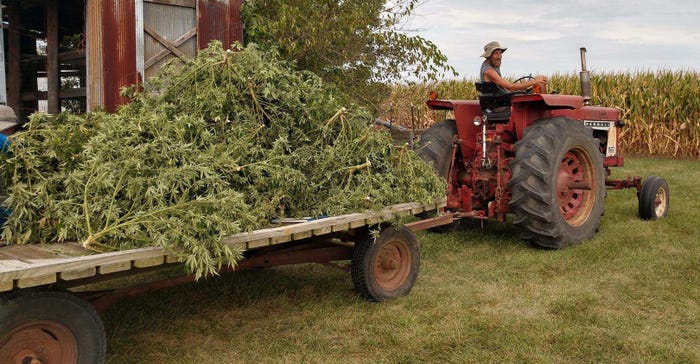
2019 was a difficult year for anyone growing a crop outdoors, but for first-time hemp farmers, uncertainties around growing something new added to rain-induced headaches. Thankfully, they had plastic Solo cups.
Varieties of hemp with high cannabidiol (CBD) and low tetrahydrocannabinol (THC) levels were sold to farmers as either seed or clones. As soils stayed saturated into mid-June in parts of Illinois and Indiana, farmers resorted to starting seeds with the infamous plastic cups.
“We had a wet spring like everyone, but we also had raised beds, and that really helped the ground to dry good enough that we could get the plants in on June 15,” says Delavan, Ill., farmer David Diekhoff. “They were getting root-bound in the cups that we were growing them in.” He grew his plants from seed to get a deep taproot established, as opposed to buying fibrously rooted clones.
The taproots can more easily reach groundwater. Because of this, Diekhoff only had to turn on his drip-line irrigation system a couple of times during a dry spell that started at the end of July near the flowering growth stage. He used much less water than Colorado growers, who have to irrigate every day.
“The nonirrigated fields I saw handled the dry spell just fine, too,” says Phillip Alberti, University of Illinois Extension specialist based in Freeport, Ill. “If those root systems were well-developed and they got the taproot burrowed down, they handled it well.”
Water, wind and weeds
Win Phippen, a Western Illinois University professor who focuses on alternative crops, adds that while 2019 was a wet year, there’s no guarantee 2020 will follow suit. That’s why he says it’s a good idea for farmers to locate hemp grown for CBD flower and extraction near wells.
“It’s labor-intensive enough as is,” Phippen says, referring to barn-busting harvests and daily scouting for pests in a crop that, so far in Illinois and Indiana, has no registered biological pesticides. Only cinnamon oil and other items the U.S. EPA considers safe for all crops can be used on hemp, though Wisconsin and other more seasoned hemp-growing states have approved hundreds of biological products for use.
Carting a tub of water from his well across an acre to his CBD field took too much time this growing season, says Marty Mahan, a Glenwood, Ind., farmer and hemp chapter president for the Indiana Farmers Union. During July, he quit irrigating, in part because his single greatest pest — his dog — would dig into the plastic covering irrigation lines and damage them. Planting took a great deal of time, as well.
“We started the seeds in Solo cups on a hay wagon that I’d take out into the sun every morning and bring back in the shed at night,” Mahan says. “They had to be hardened, which means they’re out in the elements getting used to the wind.”
Both he and Diekhoff dealt with high winds throughout the growing season, though they tried to locate their hemp fields in isolated areas with buffers. In Mahan’s case, the buffer was a field of hemp grown for fiber. The cheaper seeds got drilled close together and insulated the more spread-out, Christmas-tree-like CBD hemp. He spaced them across 10 plastic-wrapped and drip-line-irrigated rows.
“In July, we had 50-mph straight-line wind that ripped through and did some damage to the branches,” Diekhoff says. “It knocked some over, but these plants are very tough and resilient, so we were able to go up and put some fence posts up and tie them with plastic ties. The branches heal themselves from there, as long as they’re not completely severed.”
When asked how the plastic helped control weed pressure in his field, Mahan says he used an industrial weed eater with its head at an angle through the edge of the plastic, with someone following close behind with a rotary tiller. With repetitions every two weeks, he says, “It was a lot of work, and I don’t want to do that next year, so I’m thinking about using cover crops to help fight the weeds.”
Waiting on pest control options
Mahan reports minimal insect pressure during the growing season, with a few caterpillars showing up near harvest. Diekhoff likewise says praying mantises showed up in his former alfalfa field and helped keep defoliating insects such as Japanese beetles at bay. He didn’t notice any major damage.
Other farmers weren’t so lucky. During the drying process following harvest, where branches full of flowers are hung on rope in open-facing barns, Alberti recalls seeing hundreds of caterpillars drop to the floor. But the worst insects showed up earlier in the season.
“The Eurasian hemp borer was a big insect pest this year,” he says. “It burrows into the buds, causes insect damage and opens it up to pathogens. Things like gray [botrytis] and white mold infect the flower of the plant. We saw pretty much every corn insect we have. Early in the season, we saw some cutworm. We had corn borer, too. They were certainly everywhere.”
Phippen says growers aiming for CBD oil extraction will benefit from the Illinois Department of Agriculture eventually approving various biological pesticides for use on hemp, as insecticides can be extracted away during the bulk extraction process. But smokable flower is a different story. Since customers inhale it, it must be grown like food-grade vegetables and grain.
“Our growers would love to see some things approved, but I’m not sure how fast the state will move,” Phippen says. “It’s definitely going to be needed, because we saw some insects out there that were causing damage. I wouldn’t say it was major economic damage, but we definitely found insects like corn earworms feeding on the flower buds.”
About the Author(s)
You May Also Like




